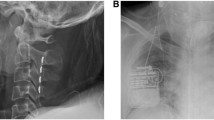Abstract
Spinal cord stimulation (SCS) has been shown to influence cerebral perfusion in both experimental models and humans. With the aim of further verifying such an effect, twelve patients had an epidural (cervical or dorsal) lead inserted percutaneously and underwent regional cerebral blood flow (rCBF) examinations (133-Xenon inhalation method) before and during SCS. Mean blood velocity (MBV) in the middle cerebral artery was also measured in seven cases by means of transcranial Doppler. In the patients with a cervical lead, a symmetrical increase in rCBF was found, mainly in the anterior regions (from +8% to +21%). MBV increased in four cervical lead implants (from +16% to +20%) and in one case with a dorsal lead (+15%). These results suggest that cerebral perfusion may increase in patients undergoing SCS through a cervical lead. Although the mechanism involved in the increase in rCBF remains to be clarified, frontal lobe functional activation by the ascending reticular pathways through the thalamo-cortical projections might be hypothesised.
Sommario
La Stimolazione Midollare Cervicale epidurale (SCS) può influenzare la perfusione cerebrale come già dimostrato in modelli sperimentali ed in clinica. Lo scopo del nostro studio è stato di verificare tale effetto in dodici pazienti sottoposti ad impianto percutaneo di elettrodo (cervicale o dorsale) per patologie diverse. In tutti i pazienti è stato effettuato uno studio del Flusso Ematico Cerebrale (FEC) con metodo inalatorio allo Xe-133, ed una determinazione della Velocità Media (VM) di flusso dell'arteria cerebrale media con Transcranial Doppler in 7 casi. Nei pazienti con elettrodo cervicale è stato osservato un aumento simmetrico del FEC compreso tra l'8% ed il 21%, prevalente nelle regioni anteriori. La VM mostrò un incremento nei 4 impianti cervicali ed in un caso con impianto dorsale con valori compresi tra il 15% ed il 20%. Nei rimanenti pazienti con impianto dorsale nessuna modificazione del FEC e della VM fu registrata. Questi risultati sembrano indicare che la perfusione cerebrale può essere modificata durante la stimolazione cervicale anche se il meccanismo fisiopatologico responsabile di tali modificazioni resta ancora da chiarire; potrebbe essere ipotizzata un'attivazione funzionale dei lobi frontali da parte del sistema reticolare ascendente attraverso le proiezioni talamo-corticali.
Similar content being viewed by others
References
Aaslid R., Markwalder T.M., Nornes H.:Non-invasive transcranial Doppler ultrasound recording of flow velocity in basal cerebral arteries. J. Neurosurg. 57: 769–774, 1982.
Barcia-Albatar J.A., Garcia-March G., Sanchez-Ledesma M.J. et al.:Does high cervical spinal cord stimulation improve cerebral blood flow conditions in brain infarction? 9th European Congress of E.A.N.S., 23–28 June, Moscow, p. 392, 1991.
Dooley D.K., Kasprak M.:Modification of blood flow to the extremities by electrical stimulation of the nervous system. South. Med. J. 69: 1309–1311, 1976.
Garcia-March G., Sanchez-Ledesma M.J., Anaja Y.A. et al.:Effect of cervical spinal cord stimulation on carotid and cerebral blood flow. An experimental study. 8th Meeting of the European Society for Stereotactic and Functional Neurosurgery. 1–3 June, Budapest, p. 106, 1988.
Hosobuchi Y.:Electrical stimulation of the cervical spinal cord increases cerebral blood flow in humans. Appl. Neurophysiol. 48: 372–376, 1986.
Matsui T., Hosobuchi Y.:The effects of cervical spinal cord stimulation on experimental stroke. Pace 12: 726–732, 1989.
Meglio M., Cioni B., Del Lago A. et al.:Pain control and improvement of peripheral blood flow following epidural spinal cord stimulation. J. Neurosurg. 54: 821–823, 1981.
Meglio M., Cioni B., Nobili F. et al.:Spinal cord stimulation and cerebral blood flow. Acta Neurochir. (Wien) 111: 43–48, 1991.
Meric P., Luft A., Seylaz J. et al.:Analysis of reproducibility and sensitivity of atraumatic measurement of rCBF in cerebrovascular diseases. Stroke 14: 82–87, 1983.
Obrist W.D., Thompson H.K., Wangs H.S. et al.:Regional cerebral blood flow estimated by 133 Xe inhalation. Stroke 6: 245–256, 1975.
Risberg J., Ali Z., Wilson E.M. et al.:Regional cerebral blood flow by 133-Xe inhalation. Preliminary evaluation of an initial slope index in patients with unstable flow compartments. Stroke 6: 142–148, 1975.
Sanchez-Ledesma M.J., Silva I., Garcia-March G. et al.:Effecto de la estimulacion electrica de la medula cervical sobre el vasoespasmo cerebral. Estudio experimental. Neurocirurgia del Descubrimiento, 22–27 November, Madrid, p. 8, 1992.
Silva I., Sanchez-Ledesma M.J., Goncalves J. et al.:Estimulacion electrica de la medula cervical, en el infar-to cerebral: bases experimentales y experiencia clinica preliminar. Neurocirurgia del Descubrimiento, 22–27 November, Madrid, p. 8, 1992.
Tallis R.C., Illis L.S., Sedgwick E.M. et al.:Spinal cord stimulation in peripheral vascular disease. J. Neurol. Neurosurg. Psychiatry 43: 476–484, 1983.
Author information
Authors and Affiliations
Rights and permissions
About this article
Cite this article
Mazzone, P., Rodriguez, G., Arrigo, A. et al. Cerebral haemodynamic changes induced by spinal cord stimulation in man. Ital J Neuro Sci 17, 55–57 (1996). https://doi.org/10.1007/BF01995709
Received:
Accepted:
Issue Date:
DOI: https://doi.org/10.1007/BF01995709




